Assessment 1: Leading and Managing Effective Workplace Relationships
VerifiedAdded on 2023/05/29
|10
|2027
|497
Homework Assignment
AI Summary
This assignment provides solutions to short answer questions related to leading and managing effective workplace relationships. It covers topics such as the Fair Work Act, EEO and anti-discrimination legislation, work health and safety, and the Privacy Act. The assignment also discusses effective feedback strategies, principles and barriers to interpersonal communication, and the importance of non-verbal communication. Furthermore, it addresses employee consultation, managing a culturally diverse workplace, and developing business networks. The solutions also touch upon reporting workplace issues, conflict resolution methods like mediation and negotiation, promoting ethics as a manager, and the significance of trust and confidence in building strong working relationships. The document concludes by highlighting the importance of transparency, effective communication, timely response, constructive feedback, and apologies in maintaining healthy internal networks. Desklib provides more solved assignments and resources for students.
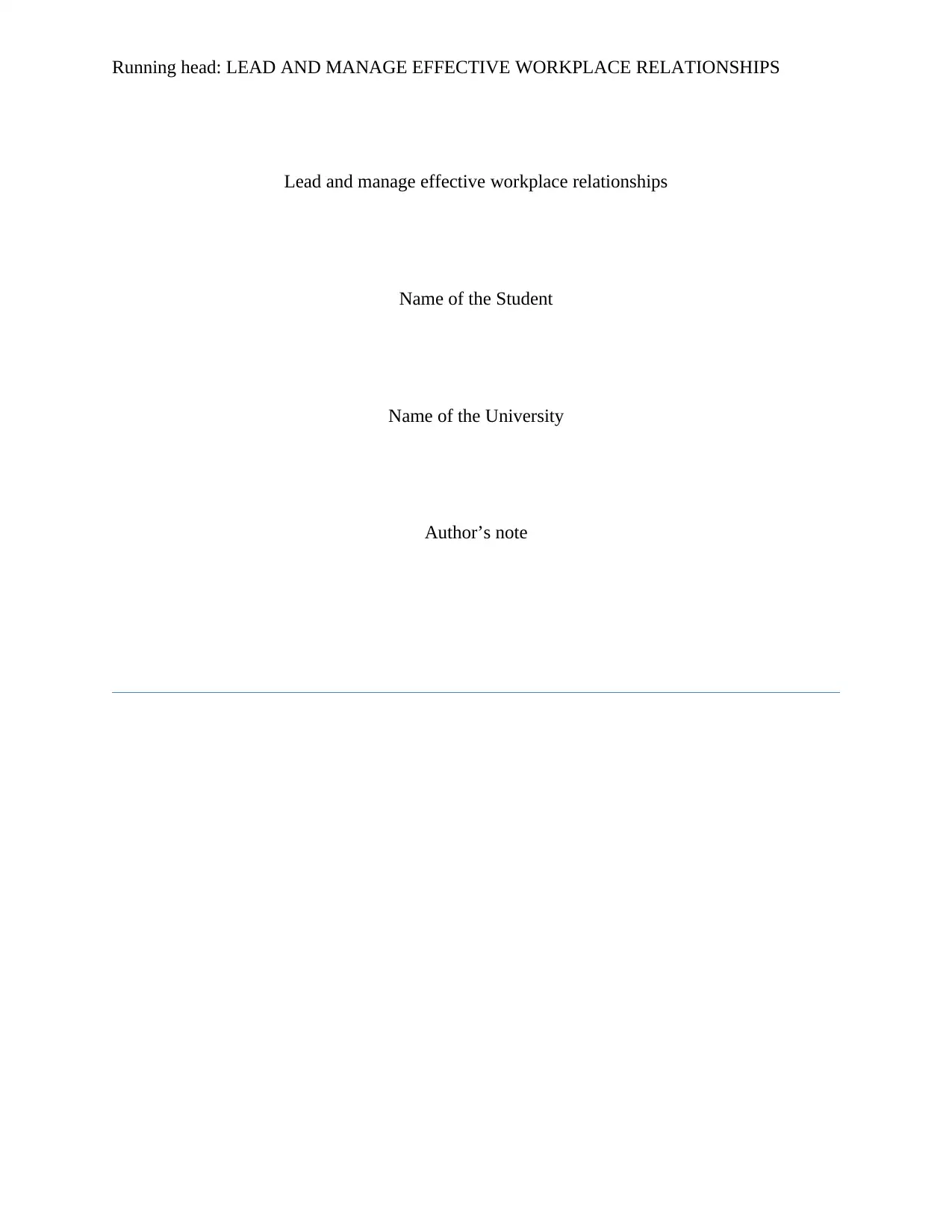
Running head: LEAD AND MANAGE EFFECTIVE WORKPLACE RELATIONSHIPS
Lead and manage effective workplace relationships
Name of the Student
Name of the University
Author’s note
Lead and manage effective workplace relationships
Name of the Student
Name of the University
Author’s note
Paraphrase This Document
Need a fresh take? Get an instant paraphrase of this document with our AI Paraphraser
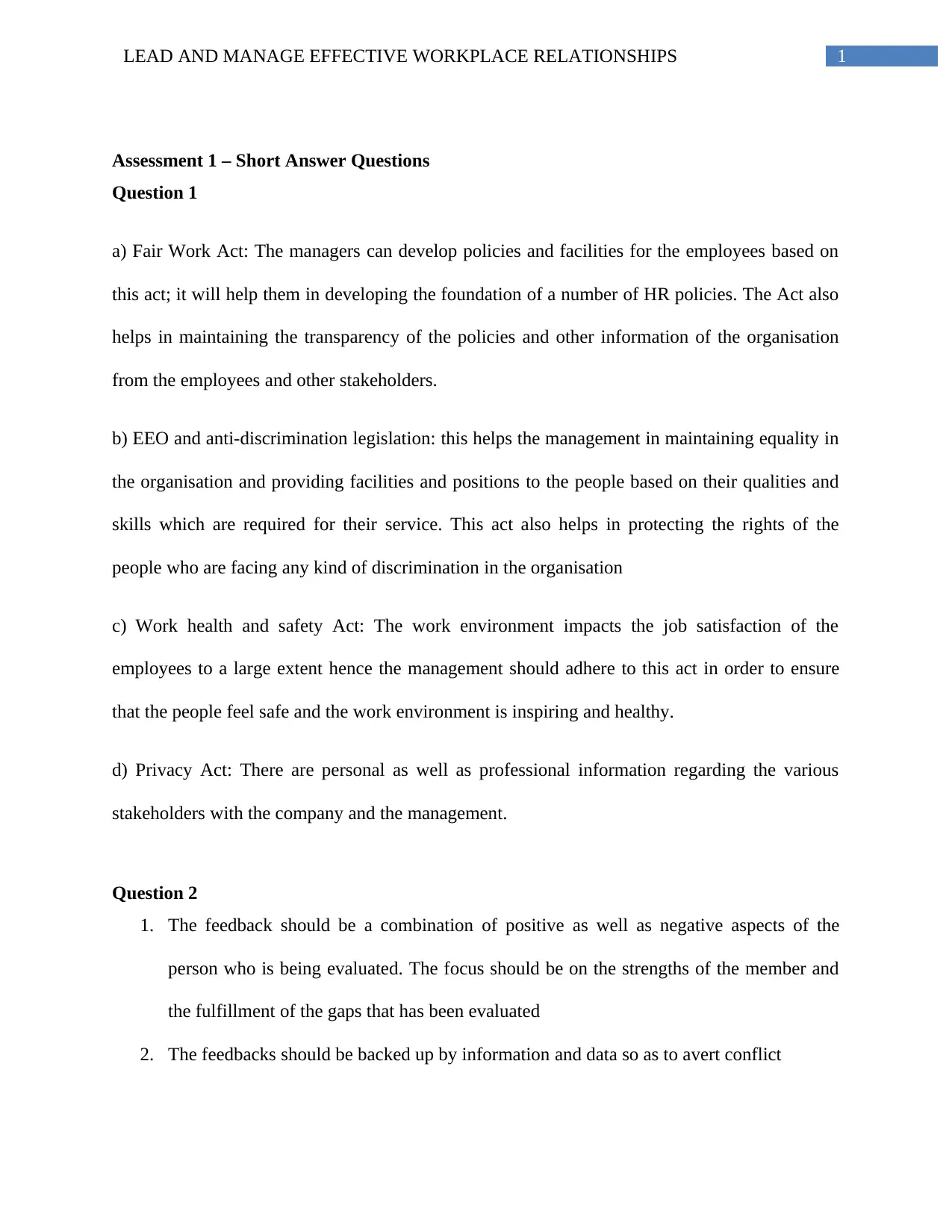
1LEAD AND MANAGE EFFECTIVE WORKPLACE RELATIONSHIPS
Assessment 1 – Short Answer Questions
Question 1
a) Fair Work Act: The managers can develop policies and facilities for the employees based on
this act; it will help them in developing the foundation of a number of HR policies. The Act also
helps in maintaining the transparency of the policies and other information of the organisation
from the employees and other stakeholders.
b) EEO and anti-discrimination legislation: this helps the management in maintaining equality in
the organisation and providing facilities and positions to the people based on their qualities and
skills which are required for their service. This act also helps in protecting the rights of the
people who are facing any kind of discrimination in the organisation
c) Work health and safety Act: The work environment impacts the job satisfaction of the
employees to a large extent hence the management should adhere to this act in order to ensure
that the people feel safe and the work environment is inspiring and healthy.
d) Privacy Act: There are personal as well as professional information regarding the various
stakeholders with the company and the management.
Question 2
1. The feedback should be a combination of positive as well as negative aspects of the
person who is being evaluated. The focus should be on the strengths of the member and
the fulfillment of the gaps that has been evaluated
2. The feedbacks should be backed up by information and data so as to avert conflict
Assessment 1 – Short Answer Questions
Question 1
a) Fair Work Act: The managers can develop policies and facilities for the employees based on
this act; it will help them in developing the foundation of a number of HR policies. The Act also
helps in maintaining the transparency of the policies and other information of the organisation
from the employees and other stakeholders.
b) EEO and anti-discrimination legislation: this helps the management in maintaining equality in
the organisation and providing facilities and positions to the people based on their qualities and
skills which are required for their service. This act also helps in protecting the rights of the
people who are facing any kind of discrimination in the organisation
c) Work health and safety Act: The work environment impacts the job satisfaction of the
employees to a large extent hence the management should adhere to this act in order to ensure
that the people feel safe and the work environment is inspiring and healthy.
d) Privacy Act: There are personal as well as professional information regarding the various
stakeholders with the company and the management.
Question 2
1. The feedback should be a combination of positive as well as negative aspects of the
person who is being evaluated. The focus should be on the strengths of the member and
the fulfillment of the gaps that has been evaluated
2. The feedbacks should be backed up by information and data so as to avert conflict
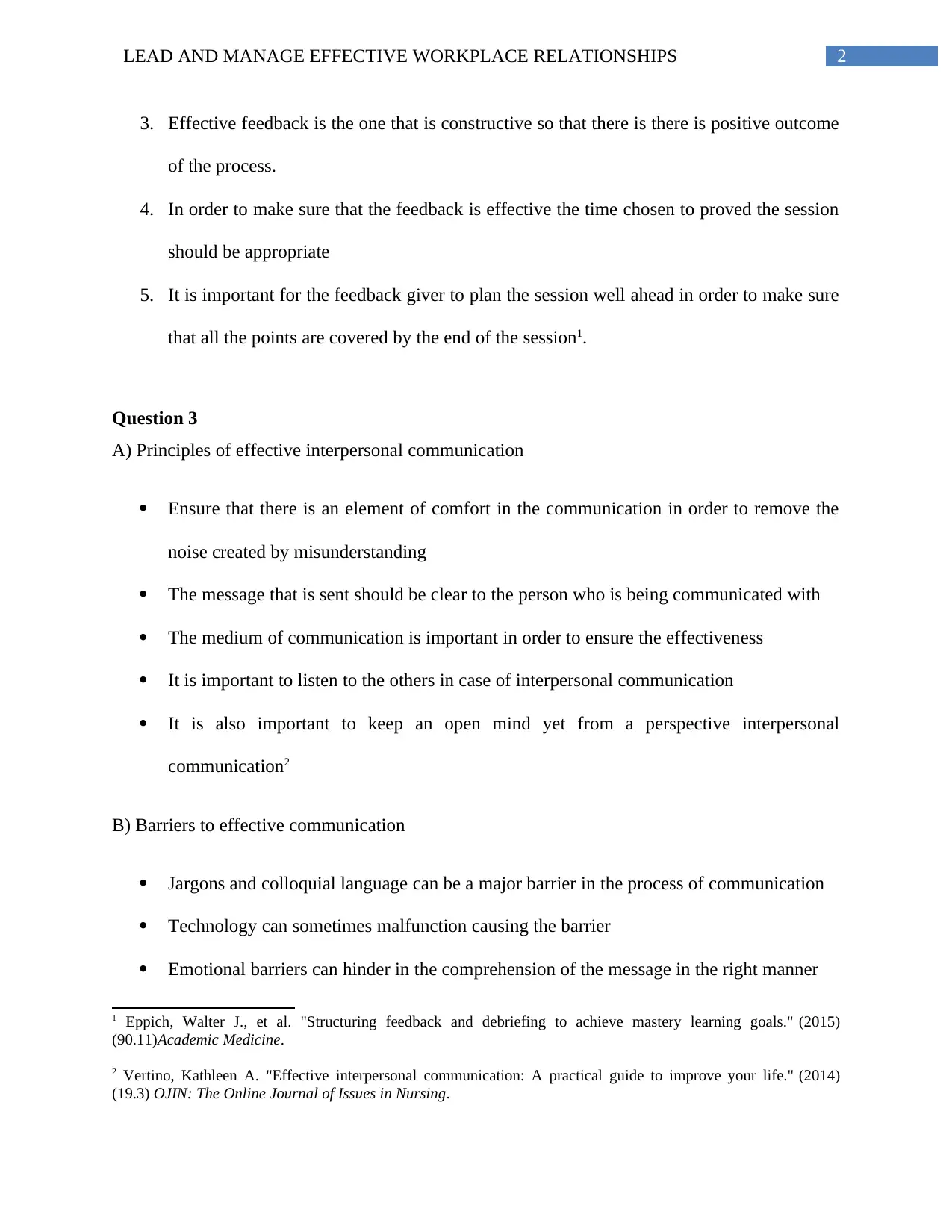
2LEAD AND MANAGE EFFECTIVE WORKPLACE RELATIONSHIPS
3. Effective feedback is the one that is constructive so that there is there is positive outcome
of the process.
4. In order to make sure that the feedback is effective the time chosen to proved the session
should be appropriate
5. It is important for the feedback giver to plan the session well ahead in order to make sure
that all the points are covered by the end of the session1.
Question 3
A) Principles of effective interpersonal communication
Ensure that there is an element of comfort in the communication in order to remove the
noise created by misunderstanding
The message that is sent should be clear to the person who is being communicated with
The medium of communication is important in order to ensure the effectiveness
It is important to listen to the others in case of interpersonal communication
It is also important to keep an open mind yet from a perspective interpersonal
communication2
B) Barriers to effective communication
Jargons and colloquial language can be a major barrier in the process of communication
Technology can sometimes malfunction causing the barrier
Emotional barriers can hinder in the comprehension of the message in the right manner
1 Eppich, Walter J., et al. "Structuring feedback and debriefing to achieve mastery learning goals." (2015)
(90.11)Academic Medicine.
2 Vertino, Kathleen A. "Effective interpersonal communication: A practical guide to improve your life." (2014)
(19.3) OJIN: The Online Journal of Issues in Nursing.
3. Effective feedback is the one that is constructive so that there is there is positive outcome
of the process.
4. In order to make sure that the feedback is effective the time chosen to proved the session
should be appropriate
5. It is important for the feedback giver to plan the session well ahead in order to make sure
that all the points are covered by the end of the session1.
Question 3
A) Principles of effective interpersonal communication
Ensure that there is an element of comfort in the communication in order to remove the
noise created by misunderstanding
The message that is sent should be clear to the person who is being communicated with
The medium of communication is important in order to ensure the effectiveness
It is important to listen to the others in case of interpersonal communication
It is also important to keep an open mind yet from a perspective interpersonal
communication2
B) Barriers to effective communication
Jargons and colloquial language can be a major barrier in the process of communication
Technology can sometimes malfunction causing the barrier
Emotional barriers can hinder in the comprehension of the message in the right manner
1 Eppich, Walter J., et al. "Structuring feedback and debriefing to achieve mastery learning goals." (2015)
(90.11)Academic Medicine.
2 Vertino, Kathleen A. "Effective interpersonal communication: A practical guide to improve your life." (2014)
(19.3) OJIN: The Online Journal of Issues in Nursing.
⊘ This is a preview!⊘
Do you want full access?
Subscribe today to unlock all pages.

Trusted by 1+ million students worldwide
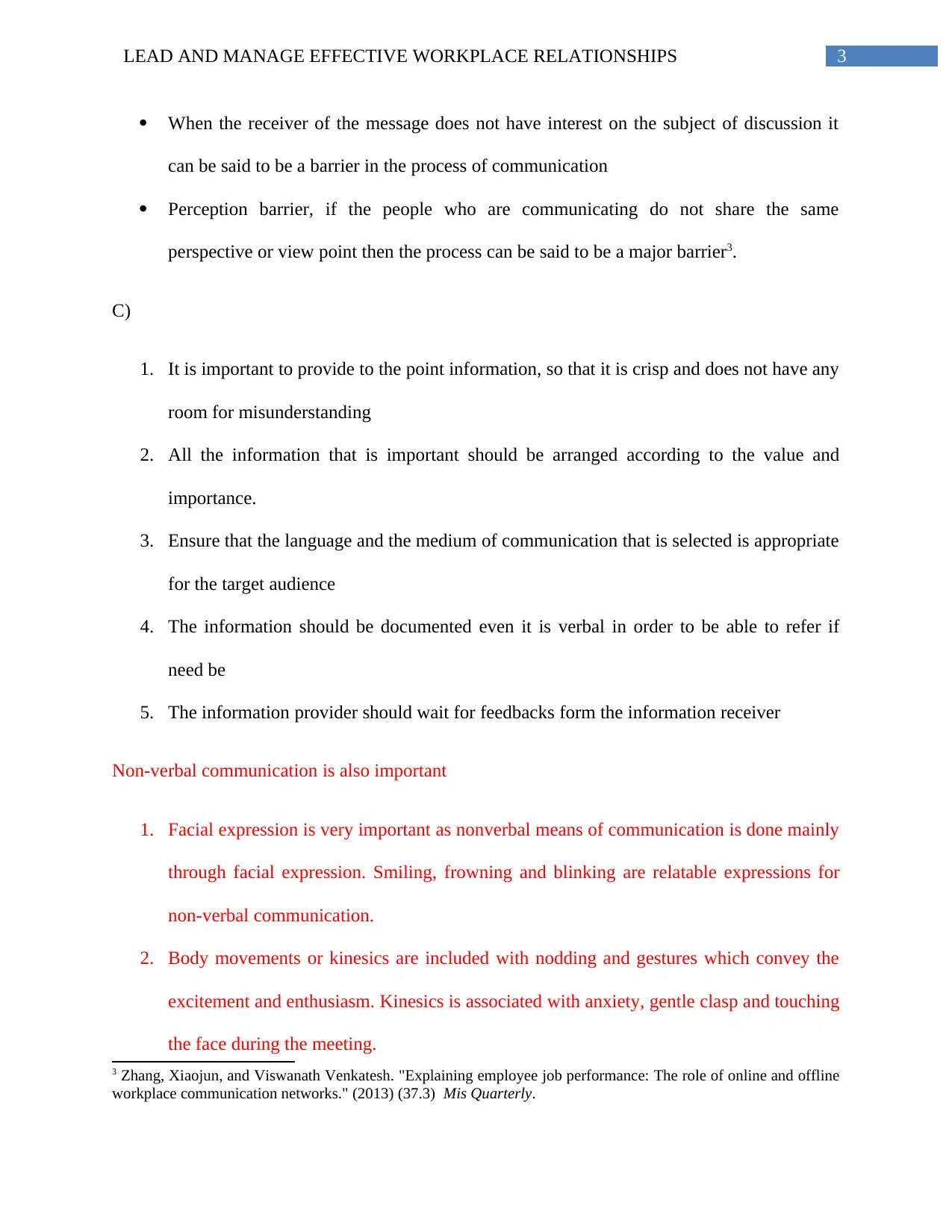
3LEAD AND MANAGE EFFECTIVE WORKPLACE RELATIONSHIPS
When the receiver of the message does not have interest on the subject of discussion it
can be said to be a barrier in the process of communication
Perception barrier, if the people who are communicating do not share the same
perspective or view point then the process can be said to be a major barrier3.
C)
1. It is important to provide to the point information, so that it is crisp and does not have any
room for misunderstanding
2. All the information that is important should be arranged according to the value and
importance.
3. Ensure that the language and the medium of communication that is selected is appropriate
for the target audience
4. The information should be documented even it is verbal in order to be able to refer if
need be
5. The information provider should wait for feedbacks form the information receiver
Non-verbal communication is also important
1. Facial expression is very important as nonverbal means of communication is done mainly
through facial expression. Smiling, frowning and blinking are relatable expressions for
non-verbal communication.
2. Body movements or kinesics are included with nodding and gestures which convey the
excitement and enthusiasm. Kinesics is associated with anxiety, gentle clasp and touching
the face during the meeting.
3 Zhang, Xiaojun, and Viswanath Venkatesh. "Explaining employee job performance: The role of online and offline
workplace communication networks." (2013) (37.3) Mis Quarterly.
When the receiver of the message does not have interest on the subject of discussion it
can be said to be a barrier in the process of communication
Perception barrier, if the people who are communicating do not share the same
perspective or view point then the process can be said to be a major barrier3.
C)
1. It is important to provide to the point information, so that it is crisp and does not have any
room for misunderstanding
2. All the information that is important should be arranged according to the value and
importance.
3. Ensure that the language and the medium of communication that is selected is appropriate
for the target audience
4. The information should be documented even it is verbal in order to be able to refer if
need be
5. The information provider should wait for feedbacks form the information receiver
Non-verbal communication is also important
1. Facial expression is very important as nonverbal means of communication is done mainly
through facial expression. Smiling, frowning and blinking are relatable expressions for
non-verbal communication.
2. Body movements or kinesics are included with nodding and gestures which convey the
excitement and enthusiasm. Kinesics is associated with anxiety, gentle clasp and touching
the face during the meeting.
3 Zhang, Xiaojun, and Viswanath Venkatesh. "Explaining employee job performance: The role of online and offline
workplace communication networks." (2013) (37.3) Mis Quarterly.
Paraphrase This Document
Need a fresh take? Get an instant paraphrase of this document with our AI Paraphraser
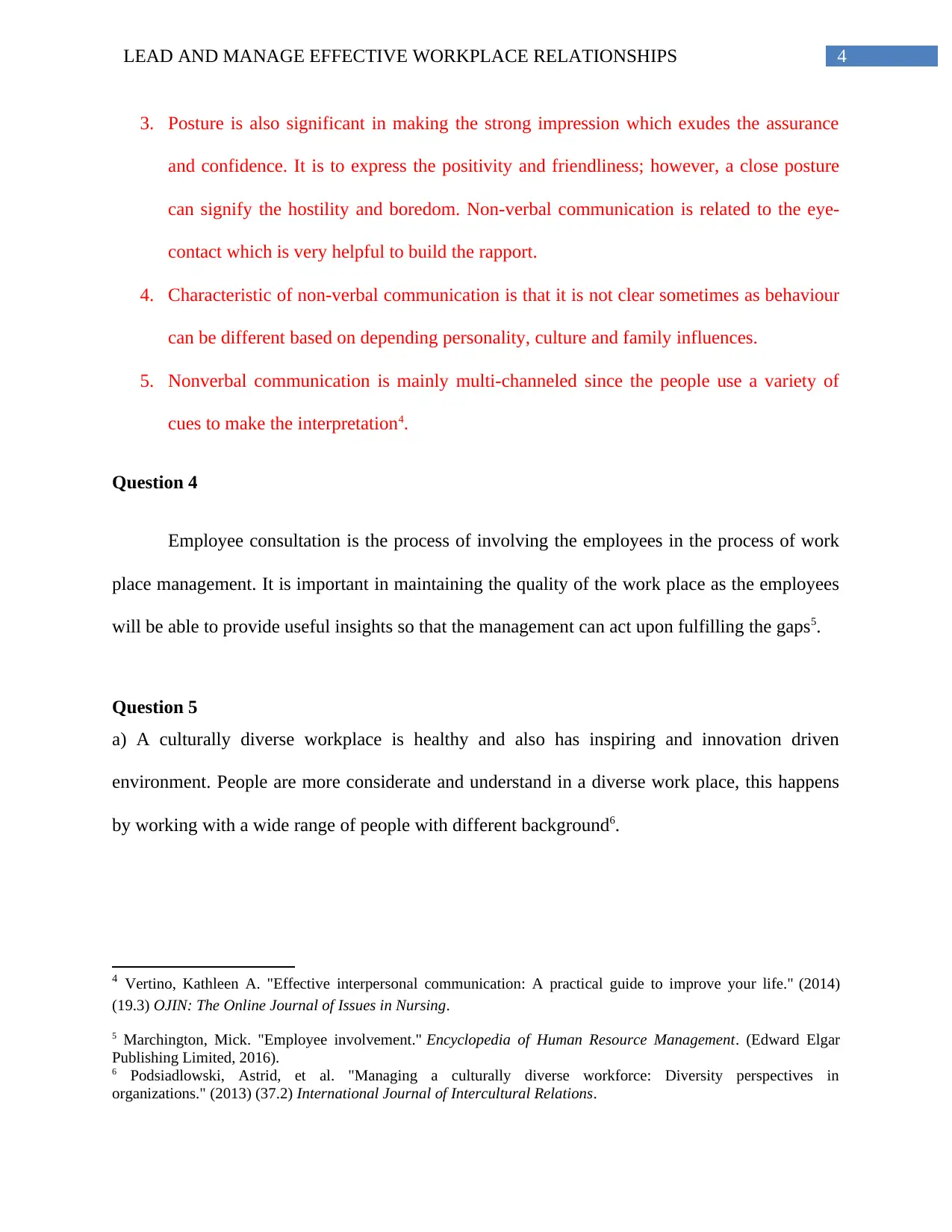
4LEAD AND MANAGE EFFECTIVE WORKPLACE RELATIONSHIPS
3. Posture is also significant in making the strong impression which exudes the assurance
and confidence. It is to express the positivity and friendliness; however, a close posture
can signify the hostility and boredom. Non-verbal communication is related to the eye-
contact which is very helpful to build the rapport.
4. Characteristic of non-verbal communication is that it is not clear sometimes as behaviour
can be different based on depending personality, culture and family influences.
5. Nonverbal communication is mainly multi-channeled since the people use a variety of
cues to make the interpretation4.
Question 4
Employee consultation is the process of involving the employees in the process of work
place management. It is important in maintaining the quality of the work place as the employees
will be able to provide useful insights so that the management can act upon fulfilling the gaps5.
Question 5
a) A culturally diverse workplace is healthy and also has inspiring and innovation driven
environment. People are more considerate and understand in a diverse work place, this happens
by working with a wide range of people with different background6.
4 Vertino, Kathleen A. "Effective interpersonal communication: A practical guide to improve your life." (2014)
(19.3) OJIN: The Online Journal of Issues in Nursing.
5 Marchington, Mick. "Employee involvement." Encyclopedia of Human Resource Management. (Edward Elgar
Publishing Limited, 2016).
6 Podsiadlowski, Astrid, et al. "Managing a culturally diverse workforce: Diversity perspectives in
organizations." (2013) (37.2) International Journal of Intercultural Relations.
3. Posture is also significant in making the strong impression which exudes the assurance
and confidence. It is to express the positivity and friendliness; however, a close posture
can signify the hostility and boredom. Non-verbal communication is related to the eye-
contact which is very helpful to build the rapport.
4. Characteristic of non-verbal communication is that it is not clear sometimes as behaviour
can be different based on depending personality, culture and family influences.
5. Nonverbal communication is mainly multi-channeled since the people use a variety of
cues to make the interpretation4.
Question 4
Employee consultation is the process of involving the employees in the process of work
place management. It is important in maintaining the quality of the work place as the employees
will be able to provide useful insights so that the management can act upon fulfilling the gaps5.
Question 5
a) A culturally diverse workplace is healthy and also has inspiring and innovation driven
environment. People are more considerate and understand in a diverse work place, this happens
by working with a wide range of people with different background6.
4 Vertino, Kathleen A. "Effective interpersonal communication: A practical guide to improve your life." (2014)
(19.3) OJIN: The Online Journal of Issues in Nursing.
5 Marchington, Mick. "Employee involvement." Encyclopedia of Human Resource Management. (Edward Elgar
Publishing Limited, 2016).
6 Podsiadlowski, Astrid, et al. "Managing a culturally diverse workforce: Diversity perspectives in
organizations." (2013) (37.2) International Journal of Intercultural Relations.
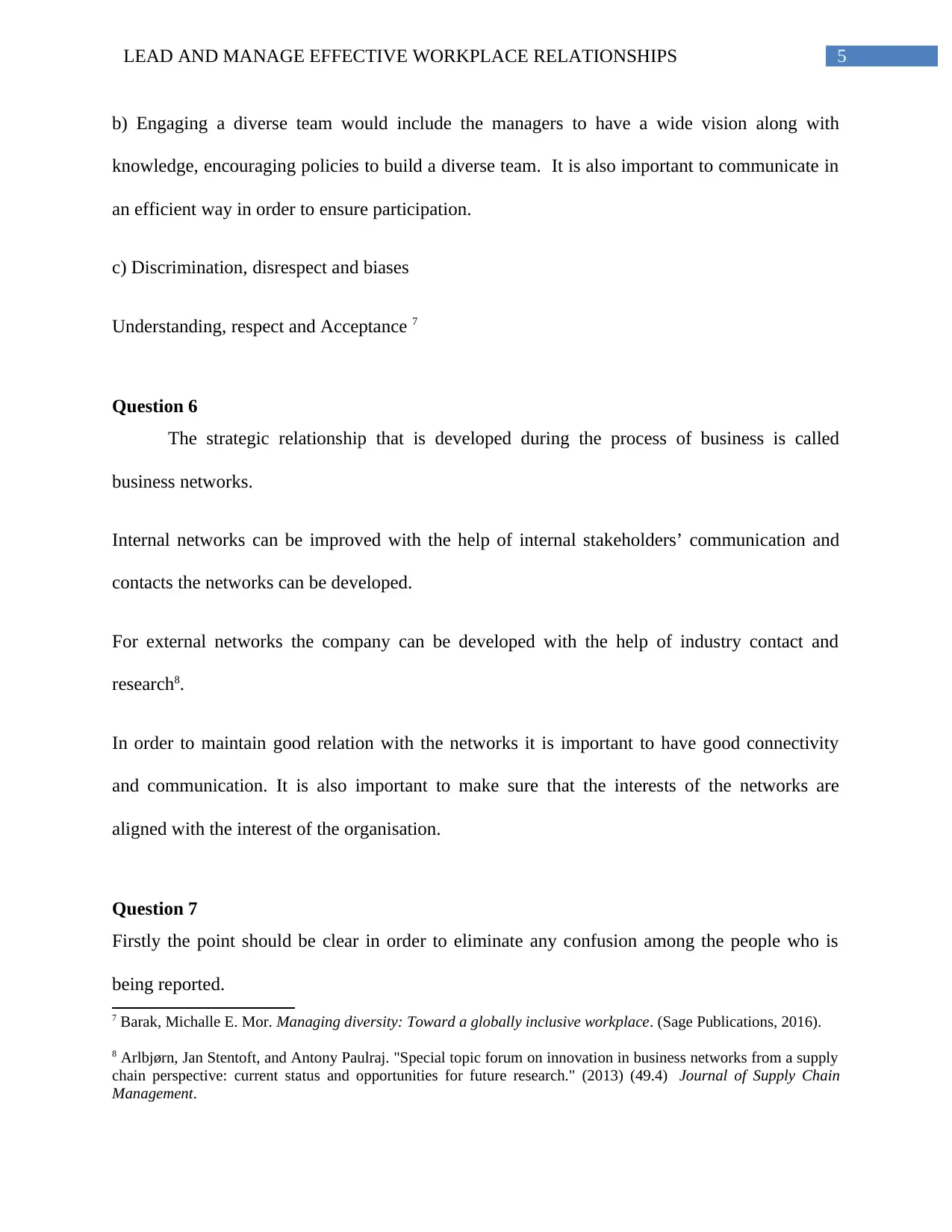
5LEAD AND MANAGE EFFECTIVE WORKPLACE RELATIONSHIPS
b) Engaging a diverse team would include the managers to have a wide vision along with
knowledge, encouraging policies to build a diverse team. It is also important to communicate in
an efficient way in order to ensure participation.
c) Discrimination, disrespect and biases
Understanding, respect and Acceptance 7
Question 6
The strategic relationship that is developed during the process of business is called
business networks.
Internal networks can be improved with the help of internal stakeholders’ communication and
contacts the networks can be developed.
For external networks the company can be developed with the help of industry contact and
research8.
In order to maintain good relation with the networks it is important to have good connectivity
and communication. It is also important to make sure that the interests of the networks are
aligned with the interest of the organisation.
Question 7
Firstly the point should be clear in order to eliminate any confusion among the people who is
being reported.
7 Barak, Michalle E. Mor. Managing diversity: Toward a globally inclusive workplace. (Sage Publications, 2016).
8 Arlbjørn, Jan Stentoft, and Antony Paulraj. "Special topic forum on innovation in business networks from a supply
chain perspective: current status and opportunities for future research." (2013) (49.4) Journal of Supply Chain
Management.
b) Engaging a diverse team would include the managers to have a wide vision along with
knowledge, encouraging policies to build a diverse team. It is also important to communicate in
an efficient way in order to ensure participation.
c) Discrimination, disrespect and biases
Understanding, respect and Acceptance 7
Question 6
The strategic relationship that is developed during the process of business is called
business networks.
Internal networks can be improved with the help of internal stakeholders’ communication and
contacts the networks can be developed.
For external networks the company can be developed with the help of industry contact and
research8.
In order to maintain good relation with the networks it is important to have good connectivity
and communication. It is also important to make sure that the interests of the networks are
aligned with the interest of the organisation.
Question 7
Firstly the point should be clear in order to eliminate any confusion among the people who is
being reported.
7 Barak, Michalle E. Mor. Managing diversity: Toward a globally inclusive workplace. (Sage Publications, 2016).
8 Arlbjørn, Jan Stentoft, and Antony Paulraj. "Special topic forum on innovation in business networks from a supply
chain perspective: current status and opportunities for future research." (2013) (49.4) Journal of Supply Chain
Management.
⊘ This is a preview!⊘
Do you want full access?
Subscribe today to unlock all pages.

Trusted by 1+ million students worldwide
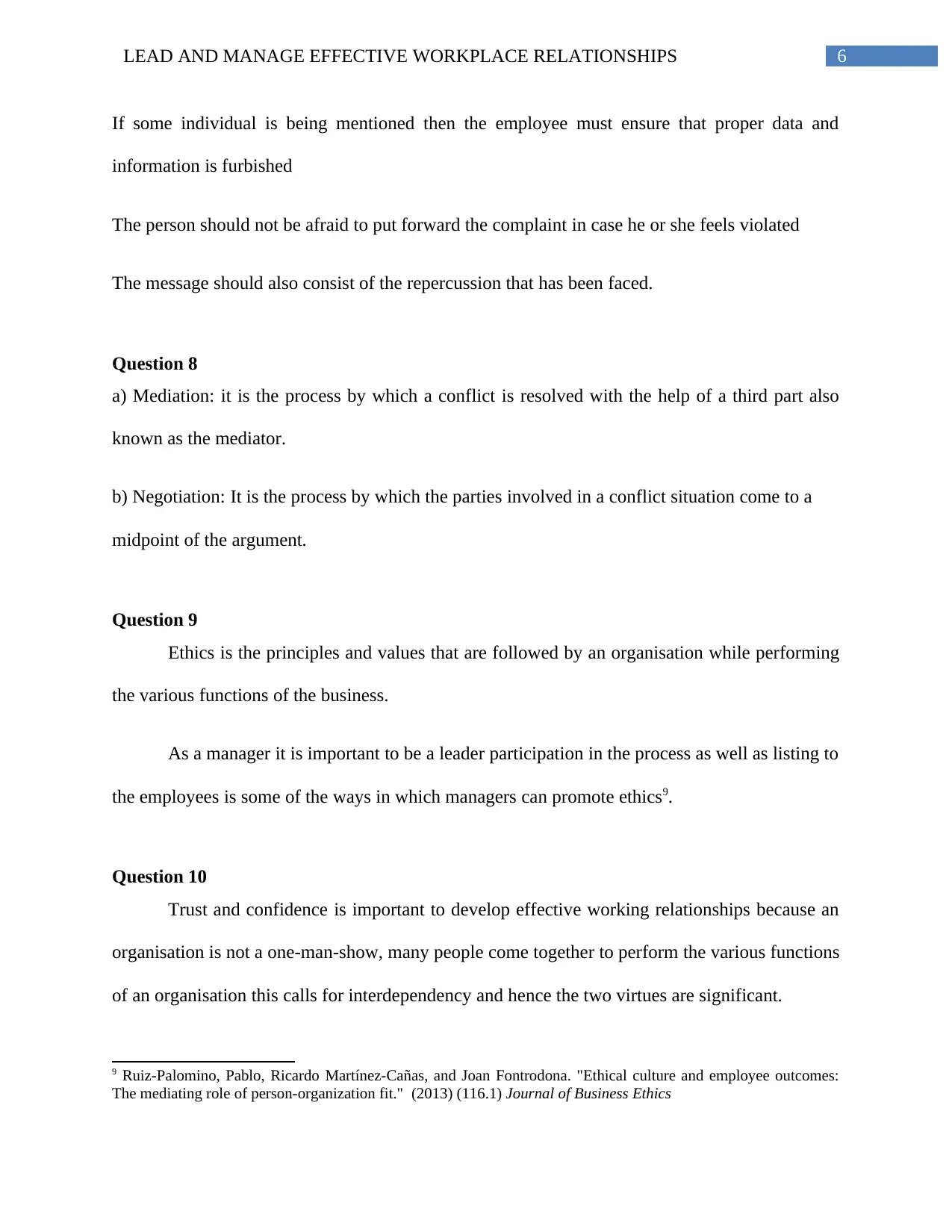
6LEAD AND MANAGE EFFECTIVE WORKPLACE RELATIONSHIPS
If some individual is being mentioned then the employee must ensure that proper data and
information is furbished
The person should not be afraid to put forward the complaint in case he or she feels violated
The message should also consist of the repercussion that has been faced.
Question 8
a) Mediation: it is the process by which a conflict is resolved with the help of a third part also
known as the mediator.
b) Negotiation: It is the process by which the parties involved in a conflict situation come to a
midpoint of the argument.
Question 9
Ethics is the principles and values that are followed by an organisation while performing
the various functions of the business.
As a manager it is important to be a leader participation in the process as well as listing to
the employees is some of the ways in which managers can promote ethics9.
Question 10
Trust and confidence is important to develop effective working relationships because an
organisation is not a one-man-show, many people come together to perform the various functions
of an organisation this calls for interdependency and hence the two virtues are significant.
9 Ruiz-Palomino, Pablo, Ricardo Martínez-Cañas, and Joan Fontrodona. "Ethical culture and employee outcomes:
The mediating role of person-organization fit." (2013) (116.1) Journal of Business Ethics
If some individual is being mentioned then the employee must ensure that proper data and
information is furbished
The person should not be afraid to put forward the complaint in case he or she feels violated
The message should also consist of the repercussion that has been faced.
Question 8
a) Mediation: it is the process by which a conflict is resolved with the help of a third part also
known as the mediator.
b) Negotiation: It is the process by which the parties involved in a conflict situation come to a
midpoint of the argument.
Question 9
Ethics is the principles and values that are followed by an organisation while performing
the various functions of the business.
As a manager it is important to be a leader participation in the process as well as listing to
the employees is some of the ways in which managers can promote ethics9.
Question 10
Trust and confidence is important to develop effective working relationships because an
organisation is not a one-man-show, many people come together to perform the various functions
of an organisation this calls for interdependency and hence the two virtues are significant.
9 Ruiz-Palomino, Pablo, Ricardo Martínez-Cañas, and Joan Fontrodona. "Ethical culture and employee outcomes:
The mediating role of person-organization fit." (2013) (116.1) Journal of Business Ethics
Paraphrase This Document
Need a fresh take? Get an instant paraphrase of this document with our AI Paraphraser
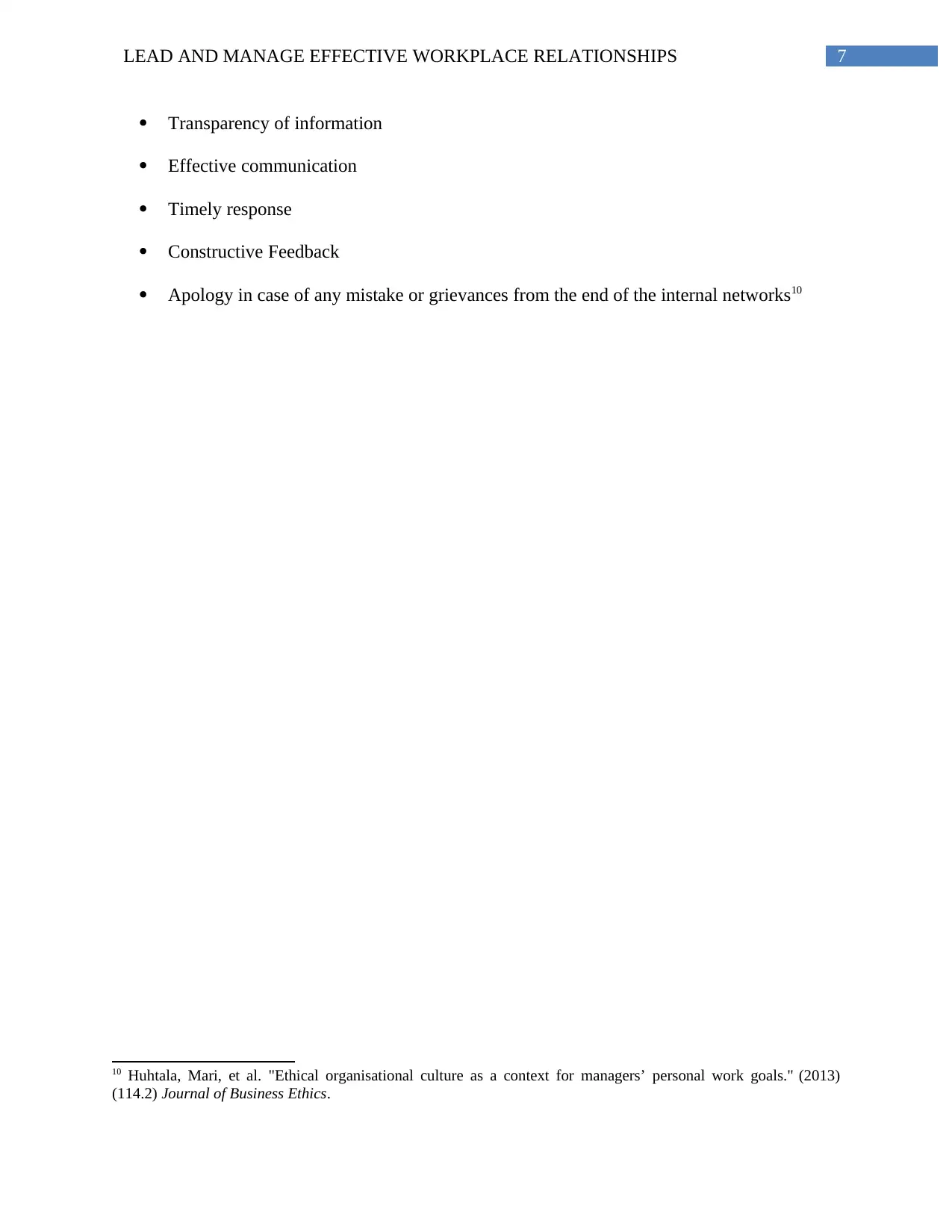
7LEAD AND MANAGE EFFECTIVE WORKPLACE RELATIONSHIPS
Transparency of information
Effective communication
Timely response
Constructive Feedback
Apology in case of any mistake or grievances from the end of the internal networks10
10 Huhtala, Mari, et al. "Ethical organisational culture as a context for managers’ personal work goals." (2013)
(114.2) Journal of Business Ethics.
Transparency of information
Effective communication
Timely response
Constructive Feedback
Apology in case of any mistake or grievances from the end of the internal networks10
10 Huhtala, Mari, et al. "Ethical organisational culture as a context for managers’ personal work goals." (2013)
(114.2) Journal of Business Ethics.
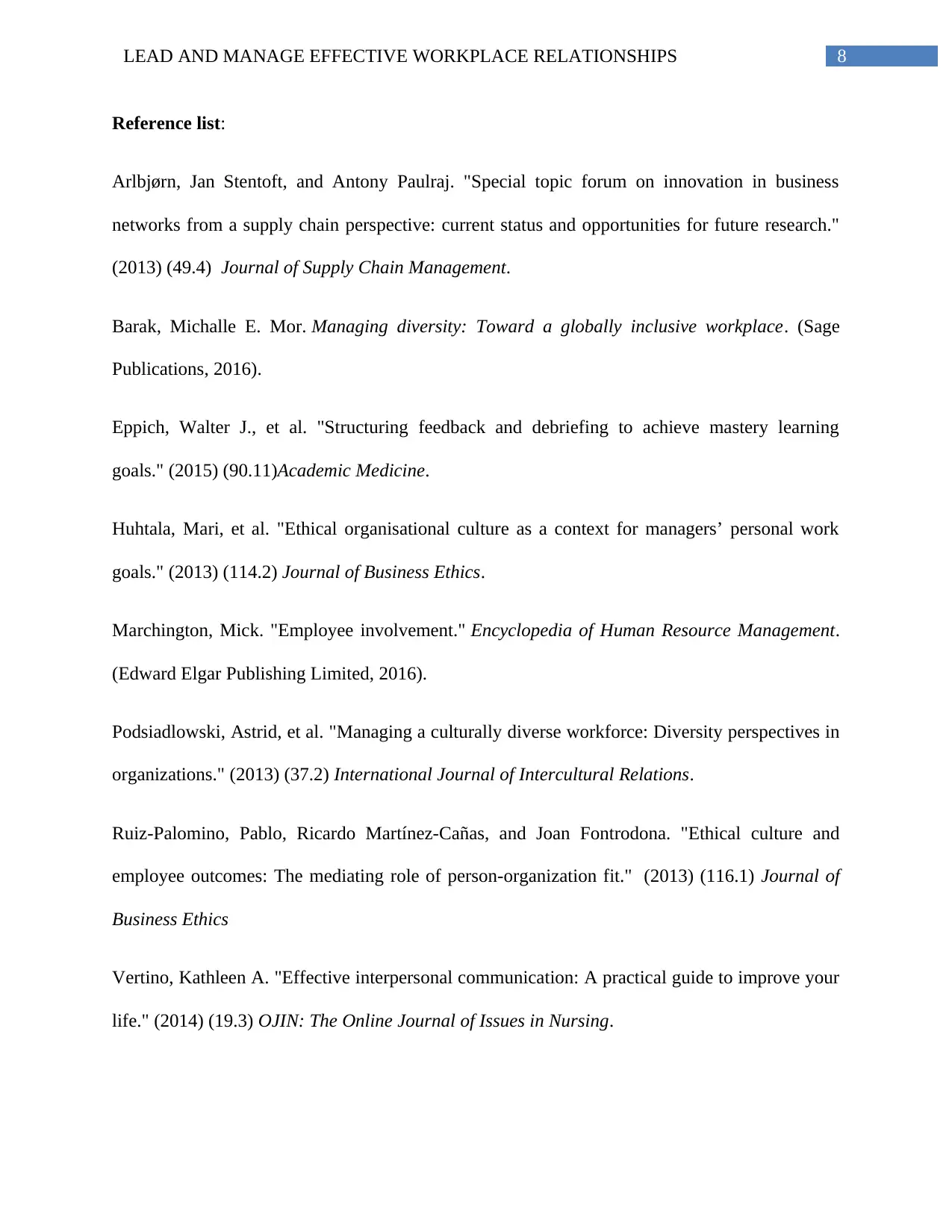
8LEAD AND MANAGE EFFECTIVE WORKPLACE RELATIONSHIPS
Reference list:
Arlbjørn, Jan Stentoft, and Antony Paulraj. "Special topic forum on innovation in business
networks from a supply chain perspective: current status and opportunities for future research."
(2013) (49.4) Journal of Supply Chain Management.
Barak, Michalle E. Mor. Managing diversity: Toward a globally inclusive workplace. (Sage
Publications, 2016).
Eppich, Walter J., et al. "Structuring feedback and debriefing to achieve mastery learning
goals." (2015) (90.11)Academic Medicine.
Huhtala, Mari, et al. "Ethical organisational culture as a context for managers’ personal work
goals." (2013) (114.2) Journal of Business Ethics.
Marchington, Mick. "Employee involvement." Encyclopedia of Human Resource Management.
(Edward Elgar Publishing Limited, 2016).
Podsiadlowski, Astrid, et al. "Managing a culturally diverse workforce: Diversity perspectives in
organizations." (2013) (37.2) International Journal of Intercultural Relations.
Ruiz-Palomino, Pablo, Ricardo Martínez-Cañas, and Joan Fontrodona. "Ethical culture and
employee outcomes: The mediating role of person-organization fit." (2013) (116.1) Journal of
Business Ethics
Vertino, Kathleen A. "Effective interpersonal communication: A practical guide to improve your
life." (2014) (19.3) OJIN: The Online Journal of Issues in Nursing.
Reference list:
Arlbjørn, Jan Stentoft, and Antony Paulraj. "Special topic forum on innovation in business
networks from a supply chain perspective: current status and opportunities for future research."
(2013) (49.4) Journal of Supply Chain Management.
Barak, Michalle E. Mor. Managing diversity: Toward a globally inclusive workplace. (Sage
Publications, 2016).
Eppich, Walter J., et al. "Structuring feedback and debriefing to achieve mastery learning
goals." (2015) (90.11)Academic Medicine.
Huhtala, Mari, et al. "Ethical organisational culture as a context for managers’ personal work
goals." (2013) (114.2) Journal of Business Ethics.
Marchington, Mick. "Employee involvement." Encyclopedia of Human Resource Management.
(Edward Elgar Publishing Limited, 2016).
Podsiadlowski, Astrid, et al. "Managing a culturally diverse workforce: Diversity perspectives in
organizations." (2013) (37.2) International Journal of Intercultural Relations.
Ruiz-Palomino, Pablo, Ricardo Martínez-Cañas, and Joan Fontrodona. "Ethical culture and
employee outcomes: The mediating role of person-organization fit." (2013) (116.1) Journal of
Business Ethics
Vertino, Kathleen A. "Effective interpersonal communication: A practical guide to improve your
life." (2014) (19.3) OJIN: The Online Journal of Issues in Nursing.
⊘ This is a preview!⊘
Do you want full access?
Subscribe today to unlock all pages.

Trusted by 1+ million students worldwide
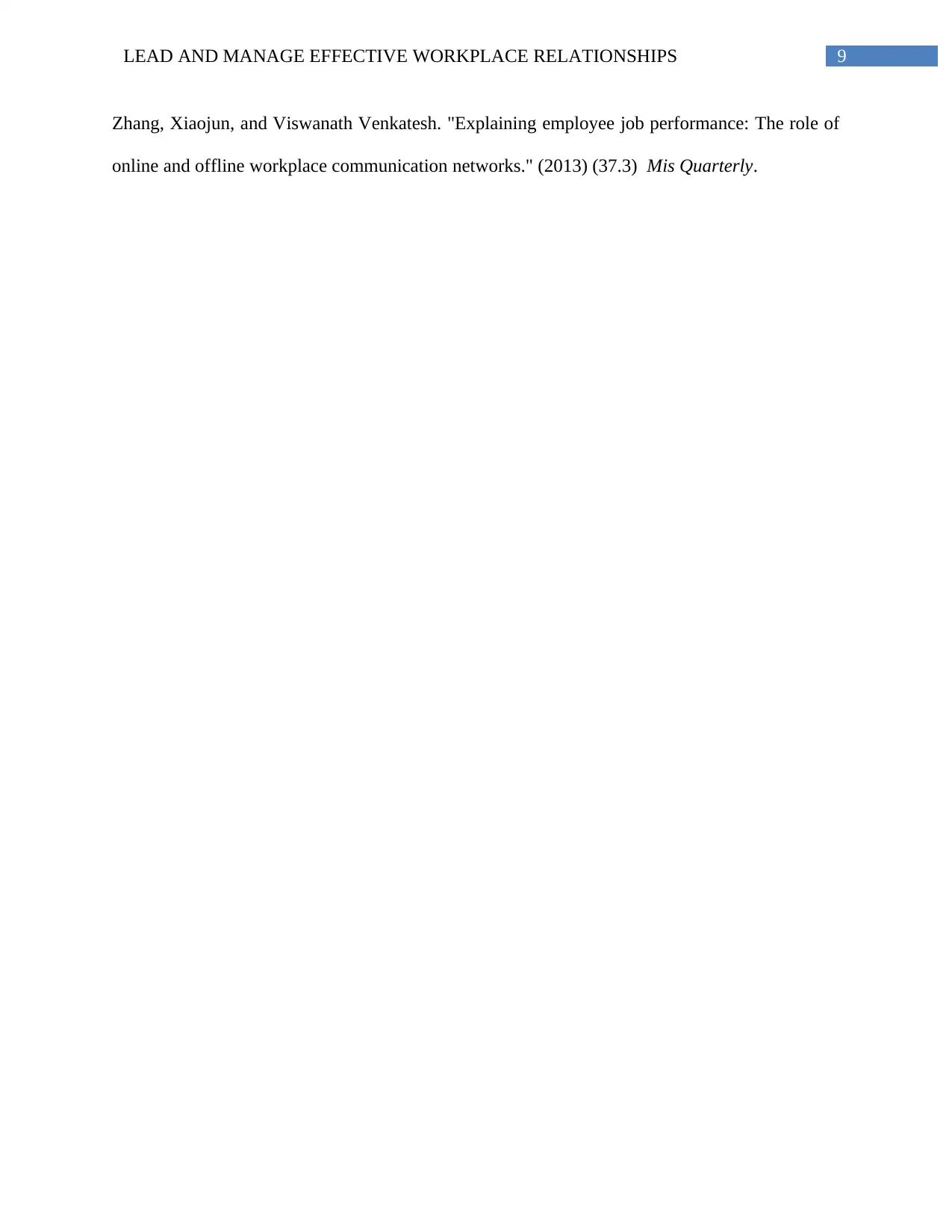
9LEAD AND MANAGE EFFECTIVE WORKPLACE RELATIONSHIPS
Zhang, Xiaojun, and Viswanath Venkatesh. "Explaining employee job performance: The role of
online and offline workplace communication networks." (2013) (37.3) Mis Quarterly.
Zhang, Xiaojun, and Viswanath Venkatesh. "Explaining employee job performance: The role of
online and offline workplace communication networks." (2013) (37.3) Mis Quarterly.
1 out of 10
Related Documents
Your All-in-One AI-Powered Toolkit for Academic Success.
+13062052269
info@desklib.com
Available 24*7 on WhatsApp / Email
![[object Object]](/_next/static/media/star-bottom.7253800d.svg)
Unlock your academic potential
Copyright © 2020–2025 A2Z Services. All Rights Reserved. Developed and managed by ZUCOL.





